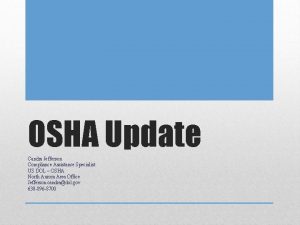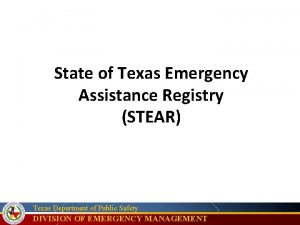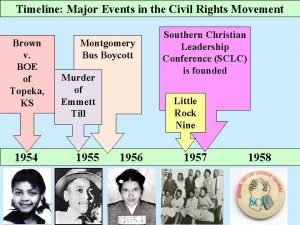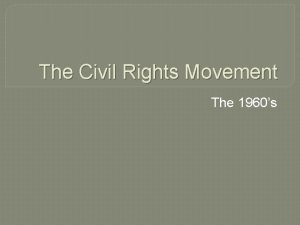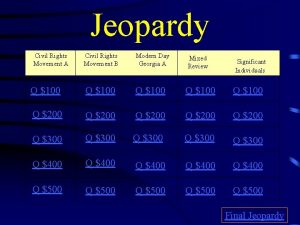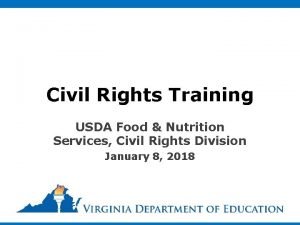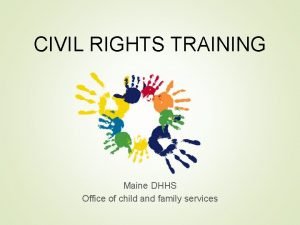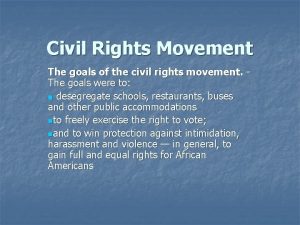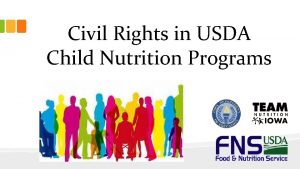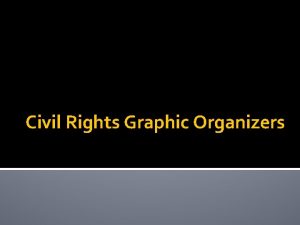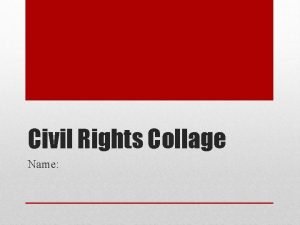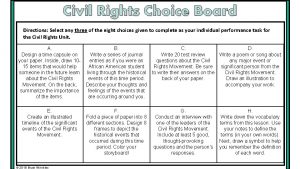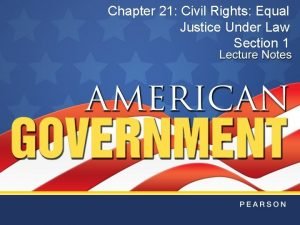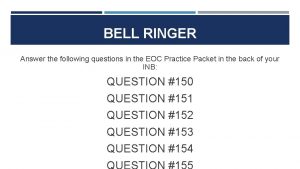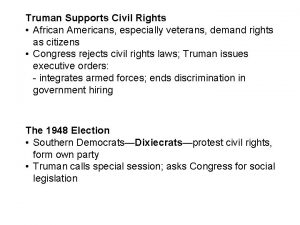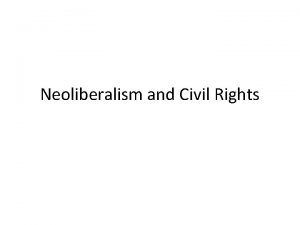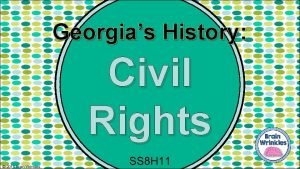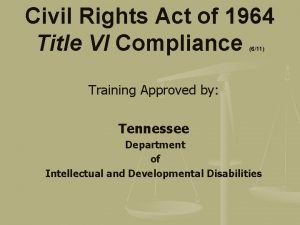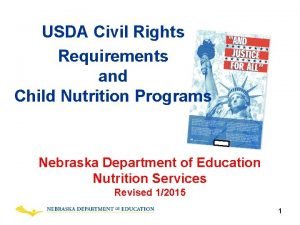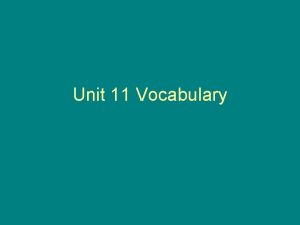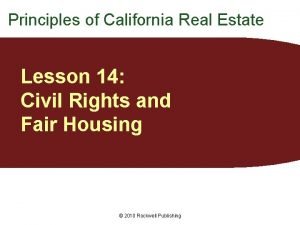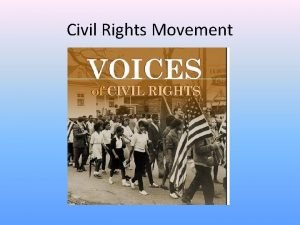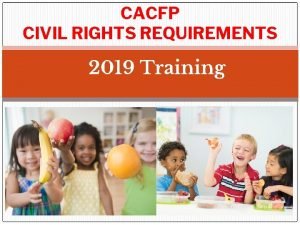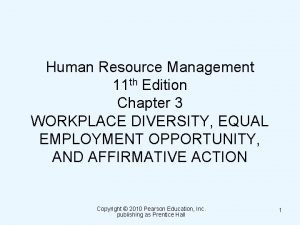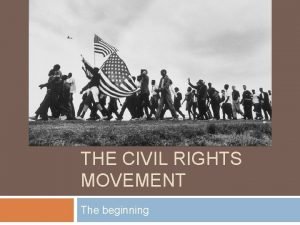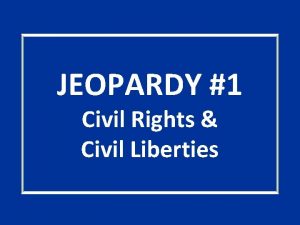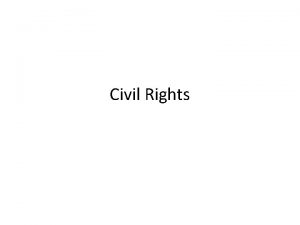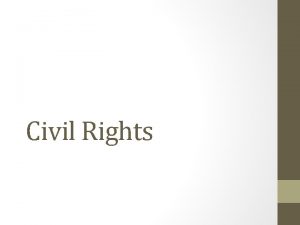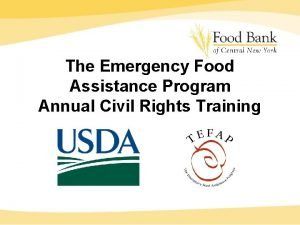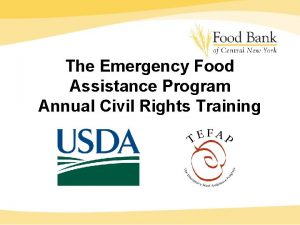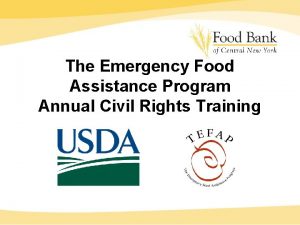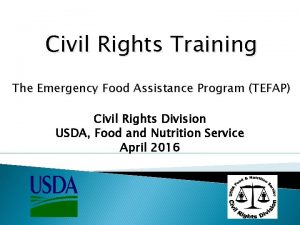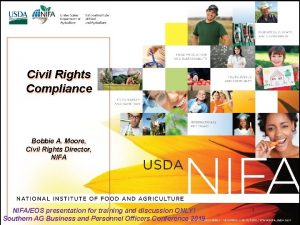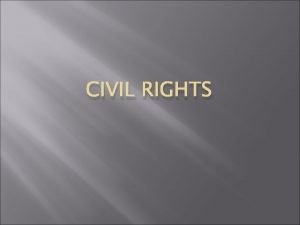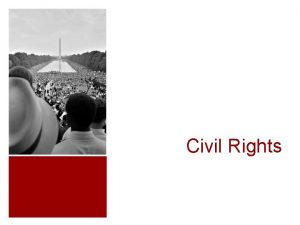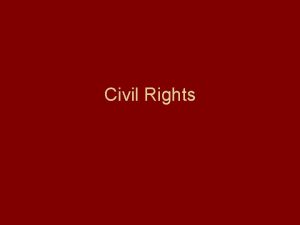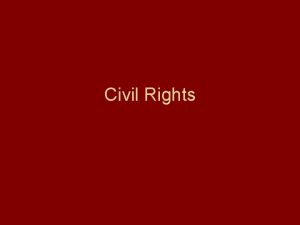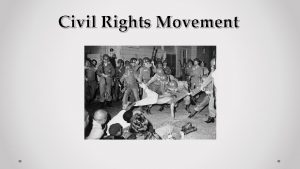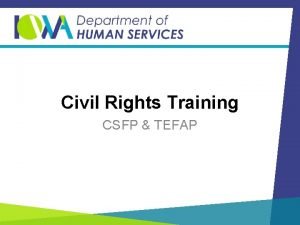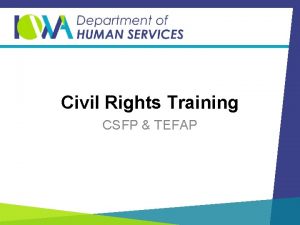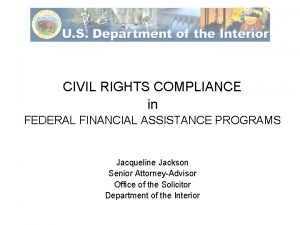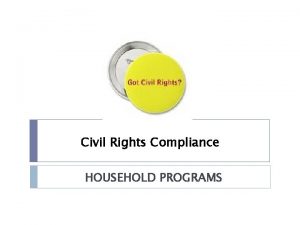Civil Rights Compliance in The Emergency Food Assistance



































- Slides: 35

Civil Rights Compliance in The Emergency Food Assistance Program (TEFAP) and the Commodity Supplemental Food Program (CSFP) Food and Nutrition Service Office of Civil Rights 1

This document was developed from: n 7 CFR Part 250 n 7 CFR Part 251 n 7 CFR Part 247 n FNS Instruction 113 -1 (revised 9/05) 2

What is Discrimination? Discrimination is defined as the act of distinguishing one person or group of persons from others, either intentionally, by neglect, or by the effect of actions or lack of actions based on the protected classes. 3

Protected Classes There are six protected classes for TEFAP and CSFP: n Race n Color n National Origin n Age n Sex n Disability 4

What is Civil Rights? The nonpolitical rights of a citizen; the rights of personal liberty guaranteed to U. S. citizens by the 13 th and 14 th amendments to the U. S. Constitution and by acts of Congress. 5

Civil Rights Laws n Title VI of the Civil Rights Act of 1964 – Covers Race, Color & National Origin n Title IX of the Education Amendments of 1972 - Sex n Section 504 of Rehabilitation Act of 1973 – Disability n Age Discrimination Act of 1975 – Age n Executive Order 13166 – Limited English Proficiency 6

Seven Areas of Civil Rights Compliance n n n n Public Notification System Data Collection Training Compliance Reviews Civil Rights Complaints Assurances Limited English Proficiency 7

Public Notification System The purpose of a public notification system is to inform applicants, participants and potentially eligible persons of the program availability, program rights and responsibilities, the nondiscrimination policy, and the procedures for filing a complaint. 8

Public Notification System Three Elements of Public Notification: 1. Program Availability 2. Complaint Information (And Justice For All Poster) 3. Nondiscrimination Statement (And Justice For All Poster) 9

Public Notification System Requirements n Publicize TEFAP & CSFP to all, including underserved populations and the entities that service them; n Provide information in alternative formats, including webbased information for persons with disabilities; n Use the nondiscrimination statement on all applicable publications; n Convey the message of equal opportunity in all graphics on all materials; and n Display the “And Justice For All” poster in a prominent location. 10

And Justice For All… 11

Pre-Award Compliance Reviews n n Pre-Approval/Pre-Award Compliance Reviews are a desk or on-site review of specific civil rights information submitted to a program applicant in the application for Federal financial assistance. No Federal financial assistance shall be made available until a Pre-Award Compliance Review has been conducted and the applicant is determined to be in compliance with civil rights requirements. 12

Data To Be Analyzed During The Pre-Award Review n Documentation of efforts that have been, or will be made to inform minority and grassroots organizations about TEFAP. Documentation may include copies of letters, lists of organizations or persons contacted; or media, if used. n An estimate of the racial/ethnic makeup of the applicant agency’s service delivery area. n Nondiscrimination statement on applicant agency’s admissions requirements. n The names of other Federal agencies providing assistance to the applicant organization and whether the applicant has ever been found to be in non-compliance by those Federal 13 agencies.

Routine (Post Award) Compliance Reviews n n n This is a desk or on-site civil rights review conducted after an organization has been authorized to receive Federal financial assistance. DCF shall conduct routine civil rights reviews during regular on-site reviews. Targeted civil rights reviews should be conducted by the DCF when there are indications of possible civil rights violations. 14

Routine Compliance Review Questions n n Do potentially eligible persons have an equal opportunity to participate? Is USDA’s “And Justice For All” poster prominently displayed where it can be seen by applicants, participants and visitors? Have civil rights training and complaint procedures been provided to persons dispensing commodities? Does the facility publicize that it provides services to all persons without regard to race, color, national origin, age, 15 sex or disability?

Routine Compliance Review Questions (continued) n n n Is the nondiscrimination statement included on all materials that describe TEFAP & CSFP? Has the agency established a public notification system to inform minorities and grassroots organizations of TEFAP, their admissions policy and civil rights complaint procedures? Is the facility accessible to the disabled? Is assistance available for persons that have limited English proficiency? Has the organization received any civil rights complaints? If yes, were they handled properly? Are the organization’s procedures adequate? 16

Nondiscrimination Statement (Revised 2015) Full Statement “In accordance with Federal civil rights law and U. S. Department of Agriculture (USDA) civil rights regulations and policies, the USDA, its Agencies, offices, and employees, and institutions participating in or administering USDA programs are prohibited from discriminating based on race, color, national origin, sex, disability, age, or reprisal or retaliation for prior civil rights activity in any program or activity conducted or funded by USDA. Cont. 17

Nondiscrimination Statement Full Statement Continued Persons with disabilities who require alternative means of communication for program information (e. g. Braille, large print, audiotape, American Sign Language, etc. ) should contact the Agency (State or local) where they applied for benefits. Individuals who are deaf, hard of hearing or have speech disabilities may contact USDA through the Federal Relay Service at (800) 877 -8339. Additionally, program information may be made available in languages other than English. Cont. 18

Nondiscrimination Statement Full Statement Continued To file a program complaint of discrimination, complete the USDA Program Discrimination Complain Form, (AD-3027) found online at: http: //www. ascr. usda. gov/complaint_filing_cust. html, and at any USDA office, or write a letter addressed to USDA and provide in the letter all of the information requested in the form. To request a copy of the complaint form, call (866) 632 -9992. Submit your completed form or letter to USDA by: Cont. 19

Nondiscrimination Statement Full Statement Continued (1) mail: U. S. Department of Agriculture Office of the Assistant Secretary for Civil Rights 1400 Independence Avenue, SW Washington, D. C. 20250 -9410; (2) fax: (202) 690 -7442; or (3) email: program. intake@usda. gov. This institution is an equal opportunity provider. ” 20

Nondiscrimination Statement n n Include the nondiscrimination statement on all materials that describe TEFAP & CSFP benefits; including web sites. For radio or television public service announcements, the nondiscrimination does not have to be read in its entirety. A short statement is sufficient. 21

Minimum (Short) Nondiscrimination Statement If written material is too small to permit the full statement to be included, the material will at a minimum include one of the following statements in print no smaller than the text: “This institution is an equal opportunity provider” 22

Nondiscrimination Statement Exception n A nondiscrimination statement is not required to be imprinted on items such as cups, buttons, magnets, pens, etc. when the size or configuration makes it impractical. 23

Civil Rights Training n n The DCF Food Distribution Unit will explain and/or train eligible recipient agencies during monitoring reviews. Site staff/volunteers should be able to identify a civil rights complaint if received. They should know what to do if they receive a complaint. They should understand that it is the basic right of the individual to file a complaint. 24

Civil Rights Complaint Handling n Right to File a Complaint: Any person alleging discrimination based on race, color, national origin, age, sex, or disability has a right to file a complaint within 180 days of the alleged discriminatory action. 25

Civil Rights Complaint Handling n n Acceptance: All civil rights complaints, written or verbal, shall be accepted and forwarded to the DCF Food Distribution Unit. DCF FDU will forward the complaint to the FNS Regional Office and DSS Office of Civil Rights. 26

Contents Of A Civil Rights Complaint n n n Name, address and telephone number, or other means of contacting of the complainant; Specific location and name of the agency delivering the service or benefit; Nature of the incident or action that led the complainant to feel discrimination was a factor, and an example of the method of administration which is having a disparate effect on the public, potential eligible persons, applicants, or participants; 27

Contents Of A Civil Rights Complaint (continued) n n n The basis on which the complainant believes discrimination exists; The names, telephone numbers, titles, and business or personal addresses of persons who may have knowledge of the alleged discriminatory action; and The date(s) during which the alleged discriminatory actions occurred. Note: Sample complaint processing form letters can be found in FNS Instruction 113 -1, Appendix E 28

Assurances To qualify for Federal financial assistance, written assurance that the program will be operated in a nondiscriminatory manner must be included in all agreements between agencies. 29

Limited English Proficiency (LEP) Definition of LEP Persons: Individuals who do not speak English as their primary language and who have a limited ability to read, speak, write, or understand English. 30

Limited English Proficiency (LEP) Where a significant number or proportion of the population eligible to be served needs service or information in a language other than English in order to be informed of, or to participate in the commodity programs, the recipient agency shall take reasonable steps to provide information in appropriate languages to such persons. 31

Reasonable Steps to Ensure LEP Persons Access to Programs Are Contingent On: n n The number or percentage of LEP persons eligible to be served; The frequency with which LEP persons come in contact with the program; The nature and importance of TEFAP & CSFP to peoples lives; and The resources available to the recipient agency and costs. 32

Limited English Proficiency (continued) Agencies that fail to provide services to LEP persons and applicants, or deny them access to TEFAP & CSFP may be discriminating on the basis of national origin in violation of Title VI. 33

Food For Thought Staff and volunteers involved in the distribution of TEFAP and/or CSFP commodities should ask themselves the following: n n Am I treating this person in the same manner I treat others? Have I given this person the opportunity to clarify all relevant factors or inconsistencies? Have I told this person exactly what information I need to make a determination on the application? Have I provided the person with the information he or she 34 needs to make necessary decisions?

THE END Questions? 35
 Civil rights webquest
Civil rights webquest Osha compliance assistance
Osha compliance assistance Texas department of public safety
Texas department of public safety Civil rights timeline of events
Civil rights timeline of events Civil rights sitins
Civil rights sitins Rosa parks mother
Rosa parks mother Chapter 14 postwar prosperity and civil rights
Chapter 14 postwar prosperity and civil rights Right to die
Right to die Civil rights movement jeopardy
Civil rights movement jeopardy Unit 7 modern ga and civil rights
Unit 7 modern ga and civil rights Usda civil rights training
Usda civil rights training Civil rights training child nutrition programs
Civil rights training child nutrition programs Goals of the civil rights movement
Goals of the civil rights movement Civil rights in child nutrition programs
Civil rights in child nutrition programs Civil rights graphic organizer
Civil rights graphic organizer Civil rights collage
Civil rights collage Civil rights choice board
Civil rights choice board Chapter 21 civil rights equal justice under law
Chapter 21 civil rights equal justice under law Chapter 20 civil liberties protecting individual rights
Chapter 20 civil liberties protecting individual rights Civil rights bell ringers
Civil rights bell ringers Truman supports civil rights
Truman supports civil rights Characteristics of civil rights
Characteristics of civil rights Civil rights cloze notes 1
Civil rights cloze notes 1 Civil rights cloze notes
Civil rights cloze notes Civil rights training quiz answers
Civil rights training quiz answers Title vi of the civil rights act of 1964
Title vi of the civil rights act of 1964 Civil rights in child nutrition programs
Civil rights in child nutrition programs Civil rights movement vocabulary
Civil rights movement vocabulary Unruh civil rights act real estate
Unruh civil rights act real estate Civil rights movement webquest
Civil rights movement webquest Civil rights movment
Civil rights movment Cacfp civil rights
Cacfp civil rights Title vii of the civil rights act
Title vii of the civil rights act Title vii of the civil rights act
Title vii of the civil rights act The civil rights movement
The civil rights movement Civil rights jeopardy
Civil rights jeopardy

